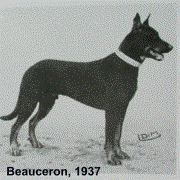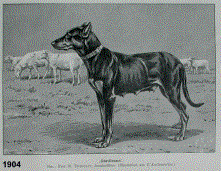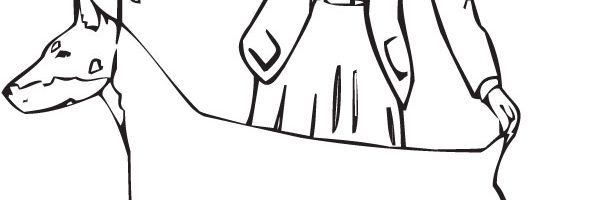Scene 1: The International Dog Show in Marseille, France. Four dogs, tense, alert, at their masters’ knees: two German Shepherds, an Airedale, a Beauceron. Padded men approach, menacing, swinging their clubs high, and the order is given: “Attack!” In a flash, the Beauceron lunges and fixes his jaws on the assailant’s arm, while the other dogs are still taking off.
Scene 2: The Beauceron ring at the same show. Off to the side, two massive adult males roll around, playing like puppies. Nearby, a 10-year-old girl pets and scratches another Beauceron that she holds on a loose leash. In the ring, a 70-pound female gently places her paws on the shoulders of her 12-year-old owner and licks her face.
With these images, you have the essence of the Beauceron: enormous physical strength coupled with a profound strength of character.
AN EXTRAORDINARY CHARACTER
Madame Vizzari, a breeder of Beaucerons in southern France, got started with the breed by chance. She rescued a Beauceron pup, raised it, fell in love, and has since raised dozens of Beaucerons.
Apparently, it is not uncommon for a Beauceron to win over an owner by its extraordinary character. “I got a Beauceron by accident,” a woman told me. “I was never really attracted to the breed. You look at it, it’s a dog. I mean, they’re good looking, but for me, nothing really special. Someone gave me one though, and he was so wonderful, so intelligent, and so good with the children, that when he died, I got another Beauceron. Same thing happened to my brother,” she went on. “I left my dog with him for two weeks. After I picked up my dog, he went out and bought a Beauceron of his own.”
Madame Vizzari agrees with the woman’s assessment of the Beauceron’s character but not that of its looks. “Noble,” she describes it, “but much more.”
When people first see a Beauce, they are afraid,” she said. “The massive head and jaw, the dark coat, the direct, frank, unwavering look. People assume the dog is mean. That is what makes the Beauce so, how shall I say? Dissuasive. That is the best word. Dissuasive. You don’t just walk up and pet one.”
Its character, though, is anything but mean. The French writer Colette was a devotee of the breed and labeled the Beauceron “the country gentleman.” The dogs are rugged and rustic looking, yet gentle and loyal, proud, serious and steady in their mission of protection and devotion.
“Affectionate, playful, superb with children, absolutely and deeply attached to their masters. But at the same time, there is something mysterious about a Beauceron. They are like some people who don’t talk much but have a strong presence. They’re quiet, and bark only to threaten, alert, or warn. . . . They have a dimension, a depth, I have not found in other dogs.”
But because of its intelligence, independence and sensitivity, the Beauceron is not a breed for the novice dog owner. According to Sue Bulanda, secretary of the North American Beauceron Club, the Beauceron is a high-energy working dog that is not suitable for an apartment or a kennel situation. The dogs do not tolerate harsh treatment from adults, and mishandling could lead to a dangerous situation, she says. Nor are the dogs suitable for a family in which everyone is gone during the day. Bulanda says Beaucerons are very sociable and don’t like being left behind.
BREED HISTORY
“The Beauceron is pure, ancient, French,” Mr. Vizzari told me. “It was formerly known as the Chien de Tourbieres. then the Bas-Rouge [because of the red, stocking-like markings on its legs]. At the first dog show in Paris in 1863. It was there as the Berger de Beauce [shepherd of the Beauce region]. It has never been crossed with anything.
“Originally, the dog worked sheep. The dog traveled 60 to 90 miles each day, trotting most of the way. He guided the sheep during long cross-country treks, and at the same time, guarded them from bears and wolves. Most sheep dogs are either guides or guards; the Beauce did both.” The Beauceron’s talents are not limited to the farm and field. In both world wars, the dogs served as ambulance, messenger and sentry dogs.
Sheep farmers no longer need dogs to guard against bears and wolves, but the Beauceron has in no way outlived its usefulness. Shepherds still use them, to be sure, but by far their biggest role now is guarding people, not sheep, and most Beauceron buyers acquire them as family guard dogs.
SIZE AND CONFORMATION
Weighing only a pound at birth, Beaucerons reach 45 to 50 pounds at 6 months and become a block of 90 to 110 pounds of muscle as adults. Males stand 25/ inches to 27/2 inches at the withers; females, 24% inches to 26% inches. The Beauceron should move with a long, ground-covering stride. It is a sleek, agile dog, able to turn on a dime.
The short, smooth coat is typically noir etfeu (black and fire), but a harlequin of reddish brown, gray and black also occurs. Though ears are usually cropped, it is not mandatory for showing, and dogs with uncropped ears are not penalized. [Cropping requirements vary from country to country.—Ed.] Shepherds originally cropped the ears of the Beauceron to avoid problems with bites from other dogs or tears from brambles.
Like its relative the Briard, another French herding breed, the Beauceron must have dewclaws: single dewclaws on the front legs and double dewclaws on the hind legs.
STRICT STANDARDS
The Vizzari’s dogs are first registered with the French equivalent of the American Kennel Club: the Societe Centrale de Canine. At 12 months, the dogs are judged for conformation to get their permanent pedigree. Beyond that, they can achieve higher rankings by going through levels of character and conformation judging. Proof of absence of hip dysplasia is also required.
In the character tests, judges look for gentleness and sociability. The judge must be able to handle a dog’s ears, feet and legs with no sign of protest from the dog. The dog is then walked on a long, loose leash. The judge suddenly fires a gun and the dog must show no fear. Finally, the judge threatens the dog with a stick. The dog can look menacing, curious or even bored, but it may not take a step back or show timidity in any way. When a dog ranks highest in a difficult series of these tests, it is classified as Elite A.
The breed is still somewhat rare, and little known outside of France. Bulanda estimates that there are fewer than 200 in the United States. “You do not see it on every street corner, and I would not want it to become that way,” Madame Vizzari said. “He has to stay mysterious, special, loved for his qualities, not popularized because of some fashion.
“I would be happy to have the Beauceron known in America,” she went on. “The Beauceron is what I think Americans are like: frank, open, honest and direct.
“They have all the qualities you look for in a dog: protection, company, sociability, gentleness, willingness, passion. “Perhaps it is the heart that is speaking,” she said, smiling at herself, “but I think not. C’est une race merveilleuse. It is a wonderful breed.”
Claudia Weisburd has written many articles about dogs and other animals. She lives in Ithaca, New York, and travels to France whenever she can.
The following article was originally published in the August 1993 issue of Dog Fancy. It is presented unchanged, although for copyright purposes, the photographs that original accompanied the article have been omitted.




